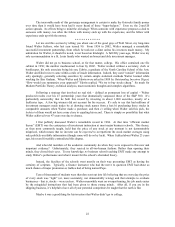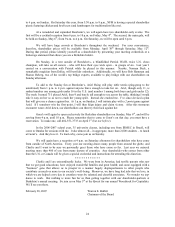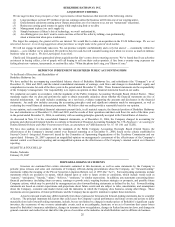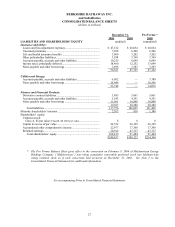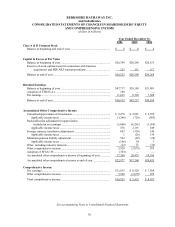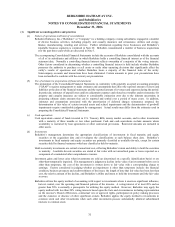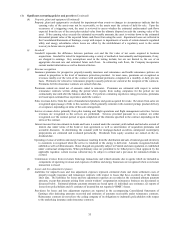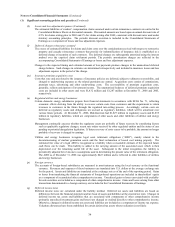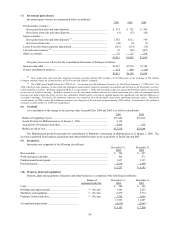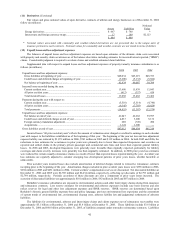Berkshire Hathaway 2006 Annual Report Download - page 33
Download and view the complete annual report
Please find page 33 of the 2006 Berkshire Hathaway annual report below. You can navigate through the pages in the report by either clicking on the pages listed below, or by using the keyword search tool below to find specific information within the annual report.32
Notes to Consolidated Financial Statements (Continued)
(1) Significant accounting policies and practices (Continued)
(d) Investments (Continued)
In applying the equity method, investments are recorded at cost and subsequently increased or decreased by Berkshire’ s
proportionate share of the net earnings or losses of the investee. Berkshire also records its proportionate share of
other comprehensive income items of the investee as a component of its comprehensive income. Dividends or other
equity distributions are recorded as a reduction of the investment. In the event that net losses of the investee have
reduced the equity method investment to zero, additional net losses may be recorded if other investments in the
investee are at-risk, even if Berkshire has not committed to provide financial support to the investee. Berkshire bases
such additional equity method loss amounts, if any, on the change in its claim on the investee’ s book value.
(e) Loans and finance receivables
Loans and finance receivables consist of commercial and consumer loans originated or purchased by Berkshire’ s
finance and financial products businesses. Loans and finance receivables are stated at amortized cost less allowances
for uncollectible accounts based on Berkshire’ s ability and intent to hold such loans and receivables to maturity.
Amortized cost represents acquisition cost, plus or minus origination and commitment costs paid or fees received,
which together with acquisition premiums or discounts are deferred and amortized as yield adjustments over the life
of the loan.
Allowances for estimated losses from uncollectible loans are recorded when it is probable that the counterparty will be
unable to pay all amounts due according to the terms of the loan. Allowances are provided on aggregations of
consumer loans with similar characteristics and terms based upon historical loss and recovery experience,
delinquency rates and current economic conditions. Provisions for loan losses are included in the Consolidated
Statements of Earnings.
(f) Derivatives
Derivative instruments include interest rate, currency, equity and credit swaps and options, interest rate caps and floors
and futures and forward contracts.
Berkshire carries derivative contracts at estimated fair value classified as assets or liabilities in the accompanying
Consolidated Balance Sheets. Such balances reflect reductions permitted under master netting agreements with
counterparties. The fair values of these instruments generally represent the present value of estimated future cash
flows under the contracts, which are a function of current underlying interest rates, currency rates, security values,
related volatility, counterparty creditworthiness and duration of the contracts. Changes in these factors or a
combination thereof may affect the fair value of these instruments.
The changes in fair value of derivative contracts that do not qualify as hedging instruments for financial reporting
purposes are included in the Consolidated Statements of Earnings as derivative gains/losses.
Derivative contracts may provide for Berkshire or the counterparty to post collateral as security against the fair value of
open or unsettled contracts. Cash collateral received from or paid to counterparties to secure derivative contract
assets or liabilities is included in liabilities or assets of finance and financial products businesses in the
Consolidated Balance Sheets. Securities received from counterparties as collateral are not recorded as assets and
securities delivered to counterparties as collateral continue to be reflected as assets in the Consolidated Balance
Sheets.
(g) Inventories
Inventories consist of manufactured goods and purchased goods acquired for resale. Manufactured inventory costs
include raw materials, direct and indirect labor and factory overhead. Inventories are stated at the lower of cost or
market. As of December 31, 2006, approximately 53% of the total inventory cost was determined using the last-in-
first-out (“LIFO”) method, 41% using the first-in-first-out (“FIFO”) method, with the remainder using the specific
identification method. With respect to inventories carried at LIFO cost, the aggregate difference in value between
LIFO cost and cost determined under FIFO methods was $263 million and $237 million as of December 31, 2006
and 2005, respectively.
(h) Property, plant and equipment
Property, plant and equipment is recorded at cost. The cost of major additions and betterments are capitalized, while
replacements, maintenance and repairs that do not improve or extend the useful lives of the related assets are
expensed as incurred. Interest over the construction period is capitalized as a component of cost of constructed
assets. In addition, the cost of constructed assets of certain domestic regulated utility and energy subsidiaries that
are subject to SFAS No. 71, “Accounting for the Effects of Certain Types of Regulation” (“SFAS 71”) includes the
capitalization of the estimated cost of capital in addition to interest incurred during the construction period. Also see
Note 1(n).
Depreciation is provided principally on the straight-line method over estimated useful lives. Depreciation of assets of
certain regulated utility and energy subsidiaries is provided over recovery periods based on composite asset class
lives as mandated by regulation.


